|
|
|
Hansen's Northwest Native Plant Database |
|
|
Northwest Native Lilies |
Photo credit: Ron Moodycliffe |
 |
|||||||||||||||||||||||||||||||||||||||||||||||||||||||
|
General Information For This Genus Click on links at bottom of this page for photos and details of each plant. |
||||||||||||||||||||||||||||||||||||||||||||||||||||||||
|
Descriptions:
Lilium is a genus of herbaceous flowering plants growing from bulbs, all with large, prominent flowers. They comprise a genus of about 110 species in the lily family Liliaceae. Most species are native to the temperate northern hemisphere, though their range extends into the northern subtropics. Lilies form an important group of flowering garden plants and are important in culture and literature in much of the world. A few species are sometimes grown or harvested for the edible bulbs. The species in genus Lilium are true lilies. Many other plants have "lily" in their common names, some of which are quite unrelated to true lilies. |
||||||||||||||||||||||||||||||||||||||||||||||||||||||||
|
||||||||||||||||||||||||||||||||||||||||||||||||||||||||
Cases of mistaken identity: northwest native
perennials incorrectly called lilies
|
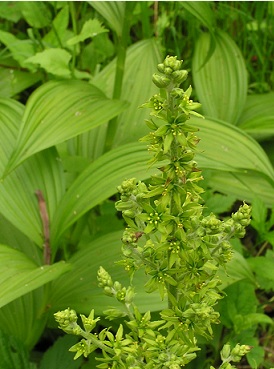
Veratrum viride (Corn Lily) Photo credit: S. B. Johnny |
|
Species Information For This Genus Click on links below for photos and details of each plant. |
|
|
A perennial that herb lives in a bulbuous cluster of several larger scales much like garlic but with many small bulblets around them reminiscent of rice grains. Flowering from May to July, there may be 1 to 8 dark brown/purple to greenish brown flowers at the top of the stems, often with yellowish streaks or spots and bear a very nasty scent. Photo credit: Transactions of the Linnean Society of London, Volume 10 - tab 11-renewed
|
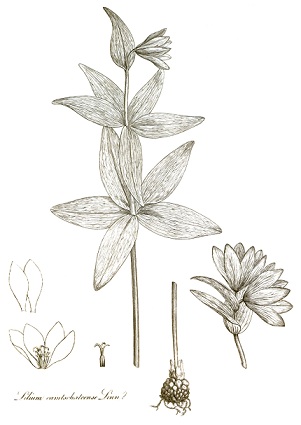 |
|
Fritillaria pudica (Yellow Bells) This is a short version of the beloved Fritillaria topping out at only 6” tall in most situations. The flowers are deep yellow with a tinge of brown around the base. Photo credit:The Garden xiii
|
 |
| Lilium bolanderi (Bolander's Lily) This northwest native lily, commonly called Bolander's Lily, is perfect for the wildlife garden. Allen's and Rufous Hummingbirds are strongly attracted to the beautiful red trumpet shaped flowers which come on a bit earlier than most other bulbous lilies native to the Pacific northwest. |
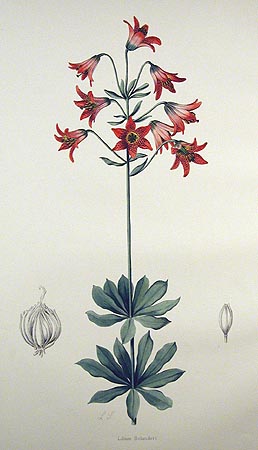 |
|
Lilium columbianum (Tiger Lily)
This beautiful perennial native lily grows from 2-4’ tall. From the whorls of 6-9 lime green leaves, stretch the flowering stalks. Each stalk is laden with clusters of 2,” bell-like, orange flowers with red spots. They hang pendant, the petals curling backwards to the stem. Photo credit: Mary Vaux Walcott from Smithsonian American Art Museum
|
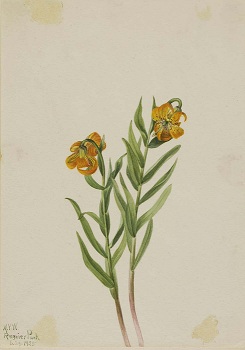 |
|
Lilium kelloggii Purdy (Kellogg's Lily) Lilium kelloggii, commonly called Kellogg's Lily, is a beautiful summer bloomer. Native to the Klamath Mountains of southern Oregon and northern California where it finds hospitable areas in the forest, even as an under story among the Coast Redwoods (Sequoia sempervirens). Photo credit: John Loganecker
|
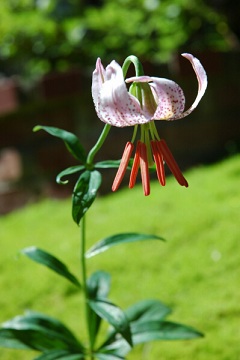 |
|
Lilium occidentale (Western Lily)
This species is now considered rare. Lilium occidentale, commonly called Western Lily, is native to southern Oregon and northern California where it has been documented in just 28 locations (down from historic locations of 58), every one within six miles of the coast. Found in coastal prairie habitats, swamps, stagnant bogs, on bluffs or sandy cliffs and in seaside spruce forested areas. Photo credit: Henry John Elwes
|
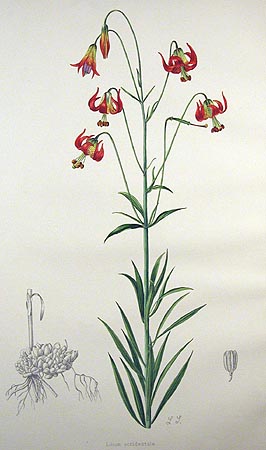 |
|
Lilium pardalinum
ssp. pardalinum (Leopard Lily)
A beautiful lily with early summer flowers of red and orange, spotted with purple. Leopard lily forms clumps and can reach 6.’ Often as many as ten pendant flowers grace each stem.
|
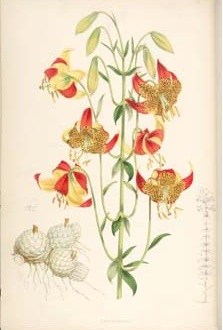 |
|
Lilium pardalinum ssp. vollmeri
(Vollmer's Lily) Lilium pardalinum Kellogg ssp. vollmeri (Eastw.) M.W. Skinner (Vollmer's lily) differs from the subspecies pardalinum in that it is taller, branches less often and less regularly. This lily does not form large colonies. The leaves are not as regularly occurring along the stems as ssp. pardalinum. Elsewise the two are very similar. Photo credit: Mrs. W.D. Bransford
|
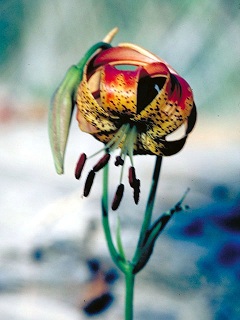 |
|
Lilium pardalinum ssp. wigginsii
(Wiggins' Lily) True to Lilium pardalinum heritage, this subspecies grows usually between 30 to 48 inches tall, from single to several stems with nodding bell-shaped flowers numbering between 2 and 35 per plant. Leaves on large plants are in 3 or 4 whorls along the stem and are from 2 to 5 inches long. In smaller plants the leaves are scattered. The yellow-orange or orange flowers are uniformly colored and have magenta to brown spots. The pollen is pale yellow to pale orange. Photo credit: Native Orchids
|
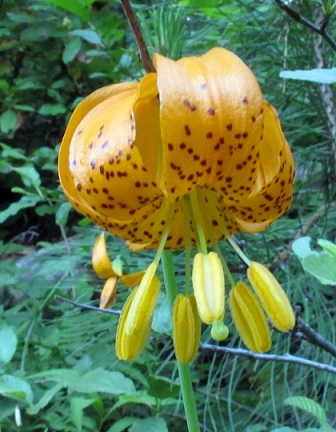 |
|
Lilium parryi (Lemon Lily) Do not confuse Lemon Lily with the daylily that shares the same common name but is not a true lily. The yellow trumpet shaped flowers have vivid brown anthers and often have maroon speckles inside. The tall flower stems can reach up to 6 feet tall and will produce several flowers per stem. |
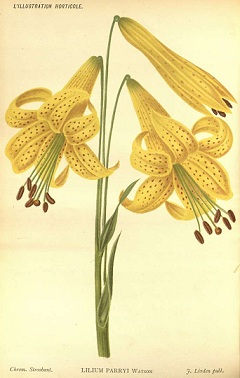 |
|
Lilium parvum (Sierra Tiger Lily, Ditch
Lily) Sierra Tiger Lily or Alpine Lily is native to the Sierra Nevada region of California, east into Nevada and on occasion a bit north into Oregon. Preferring forest regions, mountainous and in lower elevations of willow thickets, streams, wet meadows particularly where streams flow through conifers. |
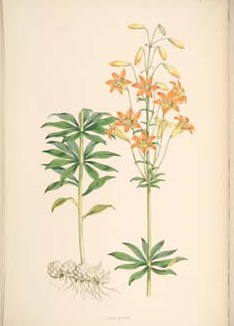 |
|
Lilium washingtonianum (Washington Lily, Cascade Lily, Mount Hood Lily) This is a tall lily reaching 3-6’ tall. The stalks are covered with fragrant trumpet shaped flowers that are white with dark purple speckles. The flowers will change from white to a purple pink color with age.
|
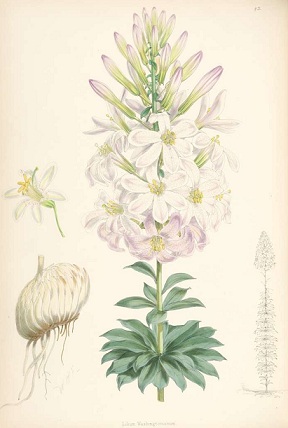 |
|
Lilium washingtonianum ssp. purpurascens
(Washington Lily, Cascade Lily, Mount
Hood Lily) This subspecies is distinguished from subspecies washingtonianum by more compact bulbs with longer scales. Photo credit: Henry John Elwes
|
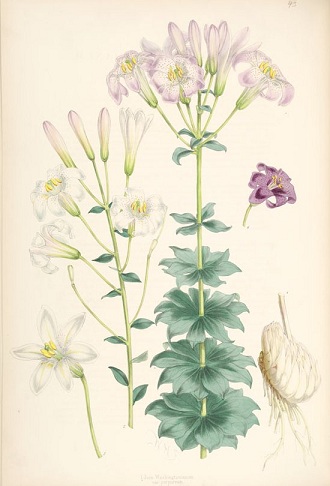 |
|